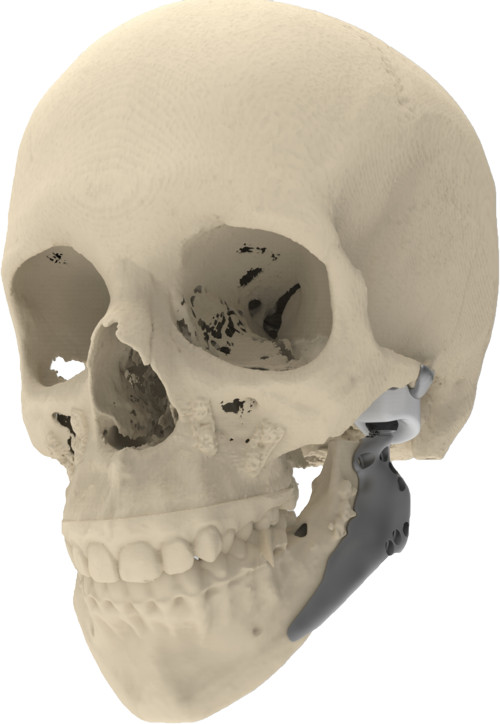TMJR Parametro™

The temporomandibular joint is prone to a range of disorders that vary from minor discomfort to those requiring replacement of the joint. Causes of disorders of the temporomandibular joint include inflammatory and degenerative arthritis, trauma, infection and complications of surgery. Symptoms include pain and difficulty in opening the mouth, and an inability to eat a normal diet.
Indications for alloplastic joint reconstruction are arthritic conditions: e.g. osteoarthritis, rheumatoid arthritis, traumatic arthritis, ankylosis (an abnormal fusion of the joint), revision procedures where other treatments have failed, avascular necrosis (death of tissue due to poor blood supply), multiple operated joints, malunited fractures, congenital malformations, benign and malign tumors.
Product specifications
The CADskills Temporomandibular Joint prosthesis is a state-of-the-art total joint replacement system. It is a complete patient-specific prosthesis. Both the eminence fossa and mandibular component are designed, considering the anatomy of the patient’s skull. This differentiates our solution from other “patient fitted” TMJ prostheses. CADskills uses a fully digital workflow to design the joint replacement. It takes only one CT scan to design a full prosthesis. Patient-specific anatomical parameters are implemented in each unique design to mimic every patient’s specific anatomy and function. In this way, the implant reliability is maximized. This relates also to the determination of screw position and screw length, as the bone quality can be determined from the scan. Screw position is a crucial factor in the primary fixation and stabilization of the implant. Secondary fixation is obtained by a scaffold at the bone touching side of the mandibular component of the implant. A lifelong stable prosthesis is obtained.
Another unique feature of CADskills TMJ prosthesis is the application of a scaffold in the condylar neck area. This scaffold forms a 3D anchoring point for the lateral pterygoid muscle by tendon reinsertion. This has the purpose to enable lateral jaw movements upon chewing. This allows adequate functional movements of the mandible, restoring patients’ quality of life.
The condylar head area that contacts with the fossa component, is HadSat® coated. The “Hard as diamond, Slick as teflon” coating ensures a maximal wear resistance. The substantial risk of metallosis due to a reaction to CoCr(Ni) is eliminated, by using a fully titanium implant. The fossa component is a combination of the CADskills 3D printed biocompatible titanium at the bone touching side and UHMWPE at the articulating surface. The UHMWPE is crosslinked and enriched with vitamin E, to improve the mechanical properties of the material. CADskills designs and delivers 3D printed surgical guides and dummies to ensure perfect resection lines, screw holes and implant positioning. Also, a complete instrument set is delivered with the implants. If desired, skin patch tests can be ordered.
CASE REPORT This 25 year old woman presented with a convex facial profile, mastication disability because of an open bite malocclusion, intractable joint pain over more than one-year period and mental depression. She had a mouth opening of 19 mm. The…
View clinical case
Contact us for more information,
fill in the form on the right or order
directly from your surgeon account.
Already have a surgeon account?

